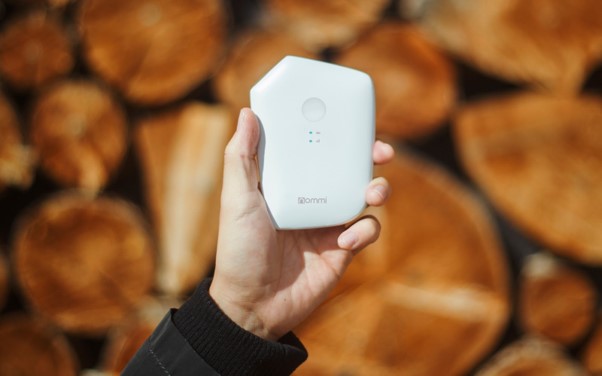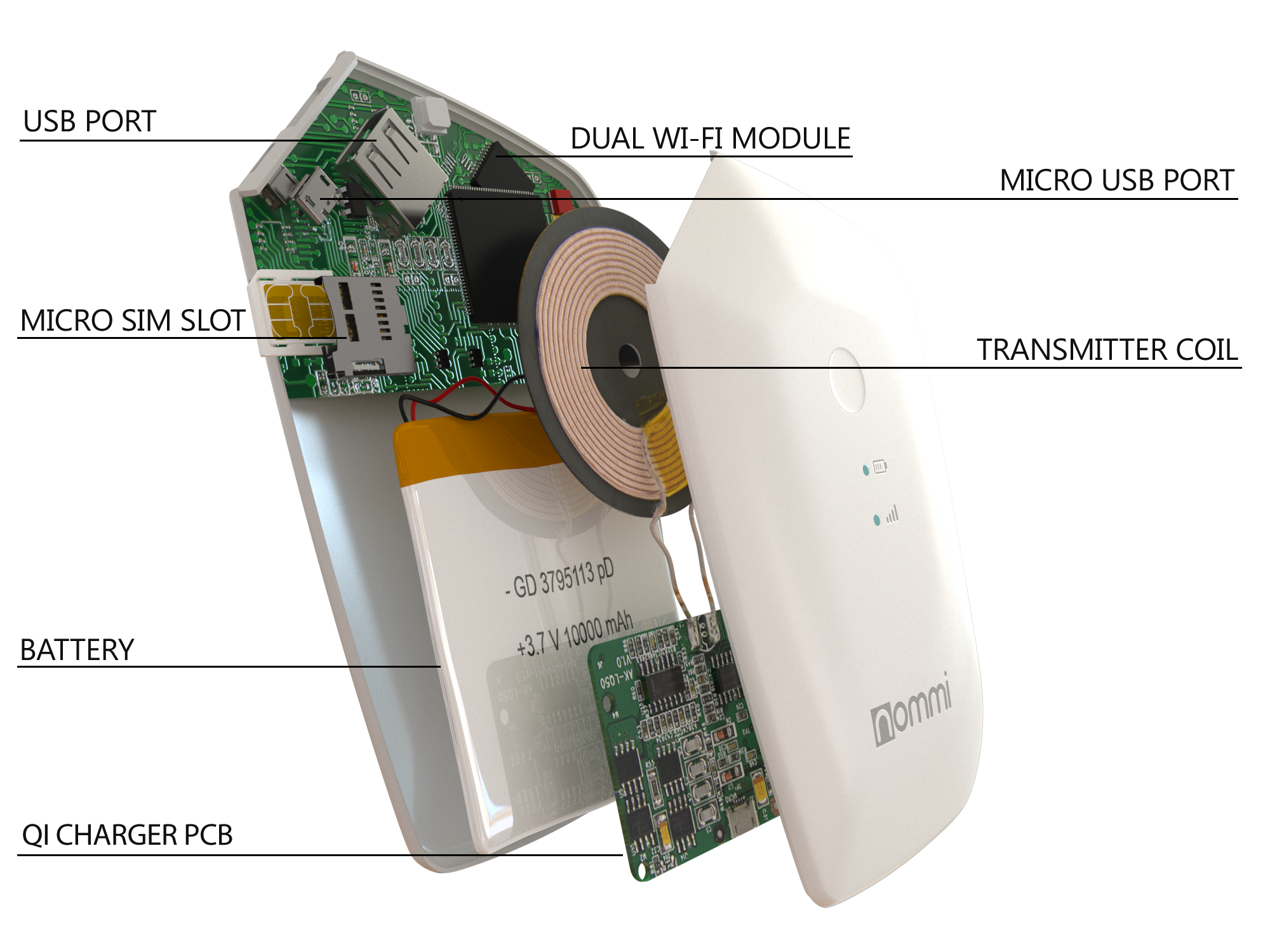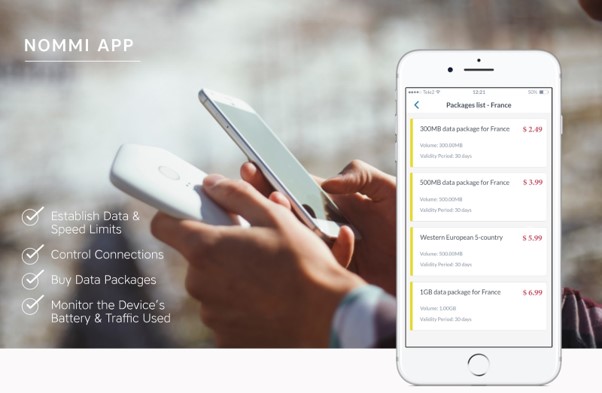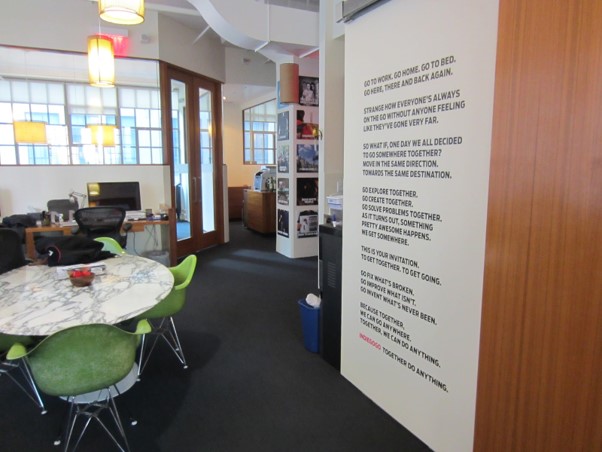How we launched the router on Indiegogo or what opportunities are there in the communications market
If you travel a lot of time and want to be in touch as soon as the plane lands at the next airport, if roaming seems expensive to you, and buying local SIM cards is a dreary process, then we have common problems and interests. In addition, I wonder why, with all the development of technology, we still use SIM cards and manually select which wi-fi point to connect to. In the publication below, I want to share what gaps still exist in the telecommunications and communications market and how we tried to address some of them in our Nommi router, which launched today at 10 a.m. US time (PST) on the Indiegogo crowdfunding site.

The idea appeared back in 2015, when together with my co-founder, we discussed for a long time that roaming is an expensive and often incomprehensible thing; in addition, having arrived in a foreign country, I want to think more about the purpose of the trip than about how and where to connect to the Internet.
Interestingly, the most significant change in the field of “smart” portable routers in recent years has been a focus on “simple” (pay X and get Y) mobile plans, no more. This is a very superficial optimization, which captures only one of the possible blocks of improvements - the one that concerns the user UX.
Immediately answering the question “what areas of optimization are there in principle”, I can say that for ourselves we have identified the following three:
1) “Device” level- depending on which device you use - it may or may not work in certain countries, at certain frequencies and have their own settings for connecting to the network;
2) “Network” level - network characteristics can vary significantly depending on the external load and it is necessary to monitor and take them into account in real time;
3) The “user” level is the most difficult, because it is important to understand what the user really needs - connection speed, quality, stability, and so on. and give him just that. Simple tariff plans, convenient switching from one operator to another - it's all here too.
Before starting development, we ordered and tested a large number of models of routers existing on the market - both intended for use in the country of residence (such as Beeline modems or Karma), and those that are mainly needed for travel (Enjoymov, Skyroam, GlocalMe). Additionally - we studied the market of travel SIM cards and roaming solutions, as one of the simplest and most popular options.

The main conclusions that we have come to:
1) Travel-sims - decisions for the most part are quite expensive, often even at the roaming level. They require a separate telephone or their dual SIM card in order not to lose important GSM calls.
2) Routers for travel - relevant on trips, but almost useless at home. They are also limited by the number of supported ranges, so it may happen that in some countries your router will not work. They also look usually not very good - for geeks, maybe it's not scary, but if you like beautiful things and you appreciate the design of your smartphone, then the appearance of the router will not bring you much pleasure.
3) Roaming - we must pay tribute - this is the easiest solution for the lazy, in addition, operators are gradually making tariffs lower. The main difficulties here are still the prices and quality of the connection obtained - often this is not 4G, but 3G, and sometimes 2G.
4) Local SIM cards - can be a good option if you are traveling abroad for a long time and you will often need to call on a regular phone. However, depending on the country and airport / station / etc. of arrival - you can spend up to an hour doing the registration and registration of the card, asking for tariffs and then activating the SIM card. If you’re in the country for a short time and you mainly need the Internet, a local SIM card may not be the cheapest solution, in addition, it often requires a separate phone or pulling out your own SIM card, unless you have a dual SIM card.
5) Your favorite smartphone - unfortunately, in most cases we still have to manually choose which wi-fi network to connect to, we may not switch to wi-fi at home, because we turned it off a little earlier in the cafe and we still carefully insert a piece of plastic called a SIM card into the phone, which is needed to transfer just a few parameters to the operator.
The task that we set ourselves was to develop a product that provides the most seamless interaction of various technologies in such a way that for the user access to the Internet is something really simple and understandable.The ideal solution in this case is the development of eSim and a number of other modifications at the smartphone firmware level, however, given what to expect such changes from Samsung / Apple and most other companies (with the possible exception of Google with their Google Pixel and a number of Red Tea Mobile devices ) is not necessary - we decided to stop on the development of a router. Being a separate unit, it allows you to make such a combination of hardware, firmware and software that will be convenient to use regardless of what model of phone or laptop you have and in addition by adding a charger to the router, we can make it more attractive for travelers , and for ordinary users - no need to wear a separate router and powerbank.
They decided to name the product Nommi - from "nomadic mi-fi", so to speak for modern digital nomads. Accordingly, they tried to make the design minimalistic on the one hand - no excesses were needed on the road, and stylish on the other hand, so that the router was more of an accessory than a gadget.
By a set of features, we focused on the following:
eSim is the so-called “built-in” or “virtual” SIM card, which can store a lot of identification numbers, as well as receive them from an operator in a particular country. It does not need to be pulled out and inserted, it is already inside the device. You don’t need to pay for roaming or buy local SIM cards in this way.
Crowdsourced password database worldwide- coupled with the device attached a large database of passwords from cafes / public places, etc. The database update is planned in the future due to the addition of passwords by Nommi users.
Dual wi-fi - a dual module allows for better switching between wi-fi and 4g: while one module keeps you on LTE, the second - scans available wi-fi networks, and also checks for a network password in the database, receives an SMS authorization (if necessary) and checks the connection speed - and if all these parameters are satisfied - it already switches you to wi-fi.
WiFi signal repeater- This feature will be useful even outside of travel. In large houses and offices, in spite of the advancement of their owners, there are still areas where the wi-fi signal is poorly caught, because the local router is far from your favorite cozy corner. By placing Nommi between you and this router, you will essentially double the distance that you can move away from it. Well, on trips it often happens that a hotel wi-fi router is in the hallway and catches well only at the door of the room. Leaving Nommi on charge at the entrance, you can be online while relaxing in bed.
Built-in Powerbank with fast charging via USB cable and Qi wireless charging support (compatible with new iPhones)- implemented in a more "capacious" version of Nommi (there are two versions in total - one with a smaller battery, the other with a larger one). It helps a lot when traveling, where the navigator and the active use of the camera consume a lot of charge.

Built-in VPN is all about security. There are many free applications both on the desktop and on smartphones, but they usually have limitations or a ton of advertising, and the convenient Opera VPN app for smartphones does not allow you to connect a laptop to it. Therefore, for the convenience of future users, we have added a built-in VPN client that can use either free servers or the data of your own server if you choose this option.
Guest wifi- when your router “broadcasts” two wifi networks. One with a complex password and only for your devices. The other is with a simple, or even completely passwordless password for your colleagues or friends and those who are not with you for long. Whom do you want to kindly give access to the Internet, but do not want viruses from their computers to scan your devices or their iPhone downloaded an update of 1 gigabyte of your traffic. Therefore, you can give them access to a special guest network, which will be isolated from your devices and limited in volume and speed of traffic.
Simple tariff plan- when traveling abroad, you can take daily packages at a price of 3-5 $ per day for 500MB on 4G, then drop to 2.5G, and at home use a regular SIM card from your favorite operator; for the USA, we have an additional monthly subscription option - $ 35 per month for 5 GB worldwide. According to the results of crowdfunding, if there are 1-2 more countries with a large number of subscribers, we will also consider a monthly plan for them, with tariffs no worse than local operators.

In order to pack all this into one router, we have developed customized firmware. And so that the user does not have to delve into the settings through the web interface, we are developing a mobile application for managing Nommi. As a result of the prototyping process, we deliberately refused the presence of a screen and control buttons on the device itself. There are so many features that it’s difficult to manipulate them through the screen, but it costs money and takes up a place in the case, which is better allocated for the battery.
The process of iterating, prototyping, finding a factory in China and preparing for the campaign as a whole took us about 6 months. We were preparing for Kickstarter initially, but literally a month before the launch, the Indiegogo guys wrote directly and were convincing enough to change our initial plans. By coincidence, our manager Indiegogo was in New York, I was there as part of the "intelligence" before the launch, so we met in the office and discussed everything verbally. Of the key “goodies” I can name: a dedicated campaign manager who advises how and what is best done; Dedicated PR-manager, helping to reach the press; additional mention in the newsletter - in general and in particular, just a little more involvement from the team, which can be expensive in conditions where you do not know the market deeply.

About the features of preparation can be read here in three parts: the first , second and third .
For those who are interested in the product: by placing an order using this link you will receive a bonus of 1GB of traffic on your device.
For those who are very interested - write in a personal, give personal links.
I hope the story was useful. :-)

The idea appeared back in 2015, when together with my co-founder, we discussed for a long time that roaming is an expensive and often incomprehensible thing; in addition, having arrived in a foreign country, I want to think more about the purpose of the trip than about how and where to connect to the Internet.
Interestingly, the most significant change in the field of “smart” portable routers in recent years has been a focus on “simple” (pay X and get Y) mobile plans, no more. This is a very superficial optimization, which captures only one of the possible blocks of improvements - the one that concerns the user UX.
Immediately answering the question “what areas of optimization are there in principle”, I can say that for ourselves we have identified the following three:
1) “Device” level- depending on which device you use - it may or may not work in certain countries, at certain frequencies and have their own settings for connecting to the network;
2) “Network” level - network characteristics can vary significantly depending on the external load and it is necessary to monitor and take them into account in real time;
3) The “user” level is the most difficult, because it is important to understand what the user really needs - connection speed, quality, stability, and so on. and give him just that. Simple tariff plans, convenient switching from one operator to another - it's all here too.
Before starting development, we ordered and tested a large number of models of routers existing on the market - both intended for use in the country of residence (such as Beeline modems or Karma), and those that are mainly needed for travel (Enjoymov, Skyroam, GlocalMe). Additionally - we studied the market of travel SIM cards and roaming solutions, as one of the simplest and most popular options.

The main conclusions that we have come to:
1) Travel-sims - decisions for the most part are quite expensive, often even at the roaming level. They require a separate telephone or their dual SIM card in order not to lose important GSM calls.
2) Routers for travel - relevant on trips, but almost useless at home. They are also limited by the number of supported ranges, so it may happen that in some countries your router will not work. They also look usually not very good - for geeks, maybe it's not scary, but if you like beautiful things and you appreciate the design of your smartphone, then the appearance of the router will not bring you much pleasure.
3) Roaming - we must pay tribute - this is the easiest solution for the lazy, in addition, operators are gradually making tariffs lower. The main difficulties here are still the prices and quality of the connection obtained - often this is not 4G, but 3G, and sometimes 2G.
4) Local SIM cards - can be a good option if you are traveling abroad for a long time and you will often need to call on a regular phone. However, depending on the country and airport / station / etc. of arrival - you can spend up to an hour doing the registration and registration of the card, asking for tariffs and then activating the SIM card. If you’re in the country for a short time and you mainly need the Internet, a local SIM card may not be the cheapest solution, in addition, it often requires a separate phone or pulling out your own SIM card, unless you have a dual SIM card.
5) Your favorite smartphone - unfortunately, in most cases we still have to manually choose which wi-fi network to connect to, we may not switch to wi-fi at home, because we turned it off a little earlier in the cafe and we still carefully insert a piece of plastic called a SIM card into the phone, which is needed to transfer just a few parameters to the operator.
The task that we set ourselves was to develop a product that provides the most seamless interaction of various technologies in such a way that for the user access to the Internet is something really simple and understandable.The ideal solution in this case is the development of eSim and a number of other modifications at the smartphone firmware level, however, given what to expect such changes from Samsung / Apple and most other companies (with the possible exception of Google with their Google Pixel and a number of Red Tea Mobile devices ) is not necessary - we decided to stop on the development of a router. Being a separate unit, it allows you to make such a combination of hardware, firmware and software that will be convenient to use regardless of what model of phone or laptop you have and in addition by adding a charger to the router, we can make it more attractive for travelers , and for ordinary users - no need to wear a separate router and powerbank.
They decided to name the product Nommi - from "nomadic mi-fi", so to speak for modern digital nomads. Accordingly, they tried to make the design minimalistic on the one hand - no excesses were needed on the road, and stylish on the other hand, so that the router was more of an accessory than a gadget.
By a set of features, we focused on the following:
eSim is the so-called “built-in” or “virtual” SIM card, which can store a lot of identification numbers, as well as receive them from an operator in a particular country. It does not need to be pulled out and inserted, it is already inside the device. You don’t need to pay for roaming or buy local SIM cards in this way.
Crowdsourced password database worldwide- coupled with the device attached a large database of passwords from cafes / public places, etc. The database update is planned in the future due to the addition of passwords by Nommi users.
Dual wi-fi - a dual module allows for better switching between wi-fi and 4g: while one module keeps you on LTE, the second - scans available wi-fi networks, and also checks for a network password in the database, receives an SMS authorization (if necessary) and checks the connection speed - and if all these parameters are satisfied - it already switches you to wi-fi.
WiFi signal repeater- This feature will be useful even outside of travel. In large houses and offices, in spite of the advancement of their owners, there are still areas where the wi-fi signal is poorly caught, because the local router is far from your favorite cozy corner. By placing Nommi between you and this router, you will essentially double the distance that you can move away from it. Well, on trips it often happens that a hotel wi-fi router is in the hallway and catches well only at the door of the room. Leaving Nommi on charge at the entrance, you can be online while relaxing in bed.
Built-in Powerbank with fast charging via USB cable and Qi wireless charging support (compatible with new iPhones)- implemented in a more "capacious" version of Nommi (there are two versions in total - one with a smaller battery, the other with a larger one). It helps a lot when traveling, where the navigator and the active use of the camera consume a lot of charge.

Built-in VPN is all about security. There are many free applications both on the desktop and on smartphones, but they usually have limitations or a ton of advertising, and the convenient Opera VPN app for smartphones does not allow you to connect a laptop to it. Therefore, for the convenience of future users, we have added a built-in VPN client that can use either free servers or the data of your own server if you choose this option.
Guest wifi- when your router “broadcasts” two wifi networks. One with a complex password and only for your devices. The other is with a simple, or even completely passwordless password for your colleagues or friends and those who are not with you for long. Whom do you want to kindly give access to the Internet, but do not want viruses from their computers to scan your devices or their iPhone downloaded an update of 1 gigabyte of your traffic. Therefore, you can give them access to a special guest network, which will be isolated from your devices and limited in volume and speed of traffic.
Simple tariff plan- when traveling abroad, you can take daily packages at a price of 3-5 $ per day for 500MB on 4G, then drop to 2.5G, and at home use a regular SIM card from your favorite operator; for the USA, we have an additional monthly subscription option - $ 35 per month for 5 GB worldwide. According to the results of crowdfunding, if there are 1-2 more countries with a large number of subscribers, we will also consider a monthly plan for them, with tariffs no worse than local operators.

In order to pack all this into one router, we have developed customized firmware. And so that the user does not have to delve into the settings through the web interface, we are developing a mobile application for managing Nommi. As a result of the prototyping process, we deliberately refused the presence of a screen and control buttons on the device itself. There are so many features that it’s difficult to manipulate them through the screen, but it costs money and takes up a place in the case, which is better allocated for the battery.
The process of iterating, prototyping, finding a factory in China and preparing for the campaign as a whole took us about 6 months. We were preparing for Kickstarter initially, but literally a month before the launch, the Indiegogo guys wrote directly and were convincing enough to change our initial plans. By coincidence, our manager Indiegogo was in New York, I was there as part of the "intelligence" before the launch, so we met in the office and discussed everything verbally. Of the key “goodies” I can name: a dedicated campaign manager who advises how and what is best done; Dedicated PR-manager, helping to reach the press; additional mention in the newsletter - in general and in particular, just a little more involvement from the team, which can be expensive in conditions where you do not know the market deeply.

About the features of preparation can be read here in three parts: the first , second and third .
For those who are interested in the product: by placing an order using this link you will receive a bonus of 1GB of traffic on your device.
For those who are very interested - write in a personal, give personal links.
I hope the story was useful. :-)
